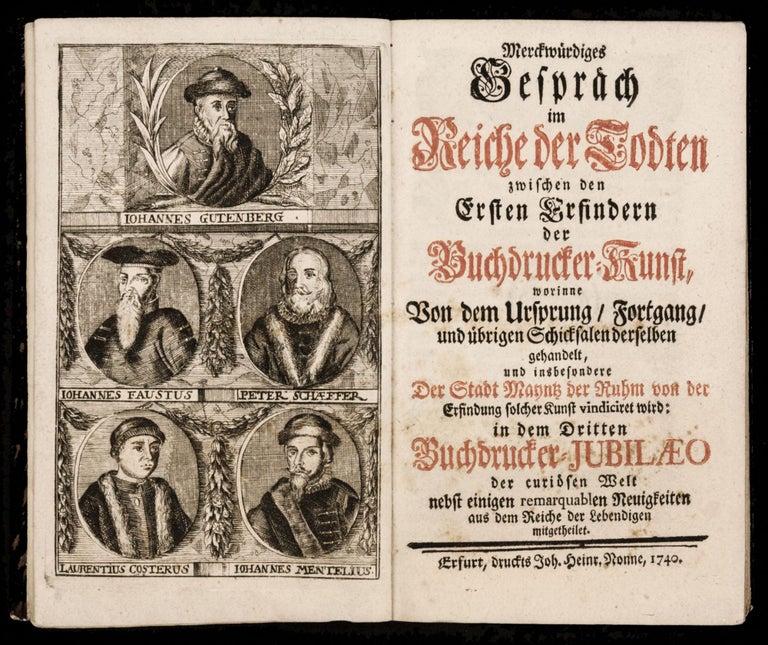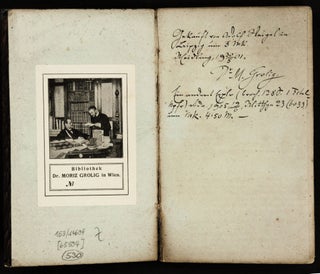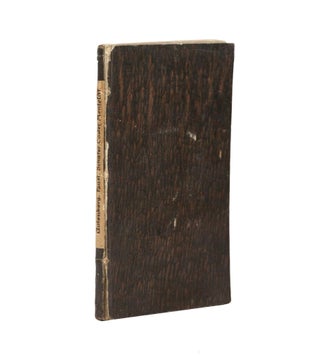Merckwürdiges Gespräch im Reiche der Todten zwischen den Ersten Erfindern der Buchdrucker-Kunst, worinne Von dem Ursprung, Fortgang, und übrigen Schicksalen derselben gehandelt, und insbesondere Der Stadt Mayntz der Ruhm von der Erfindung solcher Kunst vindiciret wird: in dem Dritten Buchdrucker-Jubilaeo der curiösen Welt nebst einigen remarquablen Neuigkeiten aus dem Reiche der Lebendigen mitgetheilet.
8vo [17.1 x 10. 4cm], 128 pp., the first leaf is a full-page engraving of portraits of the printers, with woodcut headpiece and tailpiece. Bound in contemporary pasteboards painted brown, manuscript label on spine listing printers’ names, bookplate of Dr. Moriz Grolig inside upper cover, his annotations on front flyleaf, his stamp on blank verso of title page and blank margin of final page. Upper joint separating but cords sound, lower joint tender, minor rubbing and edge wear to spine and boards. Occasional minor spotting and toning. Very rare first and only edition of this highly unusual 18th-century German work recording a lively conversation among early book printers – held from beyond the grave – in which they debate their respective roles in the invention and perfection of printing with movable type. The interlocutors are Johannes Gutenberg (c. 1400-1468), his Mainz collaborators Johann Fust (c. 1400-1466) and Peter Schoeffer (c. 1425-c.1503), and the early Strassburg printer Johannes Mentelin (c. 1410-1478); they are later joined (from the realm of the living) by a Secretarius who updates them on recent scholarship about early printing. An engraved frontispiece provides portraits of these men along with a fifth luminary in early printing, the quasi-legendary Haarlem printer Laurenz Janszoon Coster (c. 1370-1440), who is much discussed in the text but does not appear as a character in the dialogue. This anonymously authored work forms part of a peculiar genre of German Baroque literature known as Gespräche im Reiche der Todten (“Dialogues from the Realm of the Dead”), which was popularized by the Leipzig writer David Fassman (1685-1744), whose 240 such dialogues appeared in 16 volumes between 1718 and 1739. Continuations and imitations of the genre proliferated throughout the 18th-century, imagining historical or recently deceased figures in conversation in the netherworld, all with the aim of conveying to readers factual information about matters of current interest (see Sammons for a précis of this genre’s history). The event which spurred the writing of the present dialogue was the program of scholarly and civic events surrounding the celebration of the tricentennial of the invention of printing in 1440, a date mentioned in early sources as being the year in which the technology first began. In 1740 medals were struck, engravings issued, scholarly tracts published, in Haarlem, Halberstadt, and Strassburg, some advocating the primacy of Mentelin, some of Coster, and some of Gutenberg and company. These events are discussed in the dialogue, which firmly comes down in favor of the Mainz trio. Mentelin argues forcefully for his own claim, but the patient analysis of bibliographic evidence given by Gutenberg, Fust and Schoeffer (along with a healthy injection of current scholarship conveyed by the Secretarius) eventually wins the day. The work, which is certainly charming and an important example of its genre, shows a surprising level of bibliographical sophistication. The latest theories and documents on printing history – such as one would have encountered in the Michel Maittaire’s contemporary Annales typographici (1719-41) – are treated in detail. The characters discuss Gutenberg’s legal problems, rival theories that printing originated in China, the Ottoman Empire or even Mexico (in “Themistan,” i.e., Tenochtitlan), printing in exotic type (e.g. Hebrew, Arabic, Chinese, etc.), the roles of other early printers in disseminating and developing the art (Zell, Froben, Aldus, Plantin, Sweynheim and Pannartz in Rome, “Frederick Corsellis” at Oxford, etc.), the Protestant impact on printing, and the (pernicious) role of nationalism in these competing claims about printing’s origins. They cite specific copies of early books (e.g. the 1457 Mainz Psalter, the 1460 Catholicon, the 1473 Decretales, the 1459 Rationale, and the 42-line Bible) in specific libraries (e.g. at Freiburg) and quote the colophons. In the course of their conversation, the printers, in short, offer the reader a full toolbox for evaluating incunables: They discuss, for example, the transition away from manuscript culture, paper and parchment as supports, painting initials vs. printing initials, typefounding, the carryover of manuscripts abbreviations into printing, orthography, matters of pagination and foliation, the development of title pages and tables of contents, format, punctuation, illustrating books with engravings, and the printing of special materials such as music. The dialogue ends with Gutenberg thanking the Secretarius for updating them on recent scholarship and concluding that, “It remains the case that I was the original founder of the art of printing” (p. 127). OCLC locates U.S. copies at Skidmore, Columbia, and the Grolier Club. * R. M. Hoe, The Literature of Printing, p. 45; C. Sammons, “David Fassman’s Gespräche in dem Reiche derer Todten,” Yale University Library Gazette, vol. 46, no. 3 (1972), pp. 176-8; A. van der Linde, Gutenberg, Geschichte und Erdichtung aus den Quellen nachgewiesen, p. 468.
Sold



